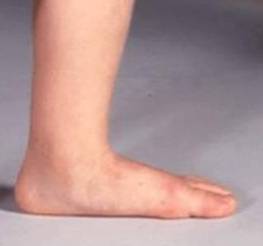|
Return to Articles Main Page
A flatfoot deformity is where the arch on the inside border of the foot is flatter than normal (the ankle rolls inward). Flatfoot deformities may occur in all age groups, but appear most commonly in children. Some of these children grow up into adults who have feet with normal arches, but many of these individuals have pain related to their flatfoot deformity throughout their lives. It is very important that children with such a deformity be evaluated by a podiatrist to determine if they need treatment to attempt to prevent future pain or deformity in their feet as an adult.
When the young child starts to first walk at about the age of 9-15 months of age, the foot has a fat or “chubby” appearance where there is a less bony architecture apparent in the foot. |

|
At this point in the development of the foot, it is very difficult to evaluate whether the child will have future problems with a flatfoot deformity.
At the ages of two and three, the child’s foot starts to show more of its characteristic shape since the foot is less fat and the bones are more prominent. If the child has a flatfoot deformity at the ages of two to three, it is wise to have the foot examined by a foot specialist. At this age, the foot is still largely made of cartilage, with less bone than is present in the adult foot. Since cartilage is relatively soft, the abnormal forces caused by a flatfoot deformity may cause permanent structural alterations to the bones and joints of the foot that will persist into adulthood.
The flatfoot deformity in children causes a number of changes to the structure of the foot which is easily recognizable by the trained podiatrist. Flatfoot deformity causes the inside arch to be flattened, causes the heel bone to be turned outward, and causes the inside aspect of the foot to appear more bowed outward than normal. Most cases of flatfoot deformity in children are also associated with excessive flexibility in the joints of the foot which is commonly caused by ligamentous laxity.
Since the flatfoot deformity causes some instability of the foot during gait, children with flatfoot deformity may have complaints in the foot such as arch, heel or ankle pain which is generally associated with increased standing, walking or running activities. However, since the excessive rolling inward of the arches of the foot also make the leg and knee more turned inwards, children with flatfeet may also complain of pain in the low back, hip, knee, or leg due to the abnormal mechanics of the foot created by the flatfoot deformity.
Diagnosis
As mentioned above, the pediatric flatfoot deformity can be diagnosed at a very early age, but is unlikely to be properly diagnosed unless the doctor is a foot specialist and is familiar with the intricacies of the structure and biomechanics of the foot. After speaking with the parent and child, the podiatrist will examine the foot both while the child is not bearing weight but also while the child is standing, walking or running. Often, the family history is also taken since the foot should be examined closely if the child has a close relative who had a painful flatfoot deformity as a child or adult.
During the examination of the child, the podiatrist is looking for abnormal structure or function of the foot and lower extremity, which could lead to problems during later childhood or adulthood. X-rays may be taken of the foot if a significant pathology is noted or suspected. The more severe the flatfoot deformity and the more significant the complaints in the foot or lower extremity, then the more likely the podiatrist will recommend specific treatment for the flatfoot deformity.
Treatment
If the child has a mild flatfoot deformity and no symptoms, then generally no treatment is recommended other than possibly yearly check-ups by the podiatrist. If, however, the child has a moderate to severe flatfoot deformity and does have significant symptoms in the foot or lower extremity, then treatment is indicated.
Treatment generally starts with both supportive shoes, such as high tops, and some form of in-shoe insert such as arch padding for the milder cases of flatfoot deformity. More significant cases of flatfoot deformity may require more exacting control of the abnormal motion of the foot such as that offered by functional foot orthotics. Orthotics limit the abnormal flat arch shape and rolling in of the heel bone during standing, walking and running activities which helps not only improve the appearance and function of the foot, but also greatly reduces the symptoms in the foot or lower extremities. Calf muscle stretching exercises are also commonly prescribed for children with tight calf muscles since these muscles can worsen the flatfoot deformity with time and make the child’s symptoms worse.
If the child has a severe flatfoot deformity and disabling symptoms which does not respond to foot orthotics, shoes and/or stretching, then foot surgery to correct the flatfoot deformity may be indicated. Flatfoot surgery is done only rarely for those children with the most severe deformities. Of course, the benefits of the surgery should be considered along with the risks associated with the surgery and a second surgical opinion is always recommended when considering flatfoot surgery on your child.
Return to Articles Main Page
Our Services | Referring Physicians | About Us | Frequently Asked Questions | Blog | Articles
Surgical Animations | Links | News & Press | Photo Gallery
Contact Us | Home | Legal Notice | Privacy Statement | Site Map
Copyright © Buffalo Medical Group P.C. / Podiatry Affiliates
Website Design, Maintenance and Hosting by Catalyst Marketing / Worry Free Websites |
